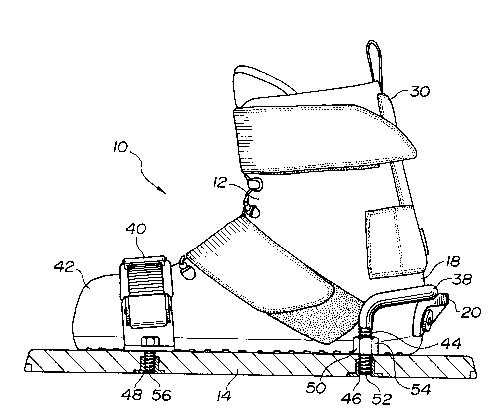Some of the information on this Web page has been provided by external sources. The Government of Canada is not responsible for the accuracy, reliability or currency of the information supplied by external sources. Users wishing to rely upon this information should consult directly with the source of the information. Content provided by external sources is not subject to official languages, privacy and accessibility requirements.
Any discrepancies in the text and image of the Claims and Abstract are due to differing posting times. Text of the Claims and Abstract are posted:
| (12) Patent Application: | (11) CA 2089313 |
|---|---|
| (54) English Title: | BOOT BINDING SYSTEM FOR A SNOWBOARD |
| (54) French Title: | SYSTEME DE FIXATION DE CHAUSSURE POUR PLANCHE A NEIGE |
| Status: | Deemed Abandoned and Beyond the Period of Reinstatement - Pending Response to Notice of Disregarded Communication |
| (51) International Patent Classification (IPC): |
|
|---|---|
| (72) Inventors : |
|
| (73) Owners : |
|
| (71) Applicants : | |
| (74) Agent: | DOUGLAS B. THOMPSONTHOMPSON, DOUGLAS B. |
| (74) Associate agent: | |
| (45) Issued: | |
| (22) Filed Date: | 1993-02-11 |
| (41) Open to Public Inspection: | 1994-08-12 |
| Availability of licence: | N/A |
| Dedicated to the Public: | N/A |
| (25) Language of filing: | English |
| Patent Cooperation Treaty (PCT): | No |
|---|
| (30) Application Priority Data: | None |
|---|
ABSTRACT OF THE DISCLOSURE
A boot binding system for a snowboard includes a rigid
heel support adapted for attachment to a heel of a boot. The
heel support has a protruding member. A rigid ankle support
is provided which is adapted for attachment along a rear seam
of a boot. The ankle support is pivotally secured to the heel
support, such that the ankle support pivots laterally, and
flexes forwardly, while providing rigid support rearwardly.
A heel binding is provided having an overlay member which
overlays the protruding member thereby preventing the heel of
the boot from being raised. A toe binding is provided which
is adapted to secure a toe of a boot to a snowboard thereby
preventing the protruding member from being moved relative to
the overlay member.
Note: Claims are shown in the official language in which they were submitted.
Note: Descriptions are shown in the official language in which they were submitted.

2024-08-01:As part of the Next Generation Patents (NGP) transition, the Canadian Patents Database (CPD) now contains a more detailed Event History, which replicates the Event Log of our new back-office solution.
Please note that "Inactive:" events refers to events no longer in use in our new back-office solution.
For a clearer understanding of the status of the application/patent presented on this page, the site Disclaimer , as well as the definitions for Patent , Event History , Maintenance Fee and Payment History should be consulted.
| Description | Date |
|---|---|
| Inactive: IPC deactivated | 2012-01-07 |
| Inactive: IPC expired | 2012-01-01 |
| Inactive: IPC from PCS | 2012-01-01 |
| Inactive: IPC from PCS | 2012-01-01 |
| Inactive: First IPC from PCS | 2012-01-01 |
| Inactive: IPC from PCS | 2012-01-01 |
| Inactive: IPC from MCD | 2006-03-11 |
| Time Limit for Reversal Expired | 1999-02-11 |
| Application Not Reinstated by Deadline | 1999-02-11 |
| Deemed Abandoned - Failure to Respond to Maintenance Fee Notice | 1998-02-11 |
| Application Published (Open to Public Inspection) | 1994-08-12 |
| Abandonment Date | Reason | Reinstatement Date |
|---|---|---|
| 1998-02-11 |
Note: Records showing the ownership history in alphabetical order.
| Current Owners on Record |
|---|
| RANDY JESPERSEN |
| Past Owners on Record |
|---|
| None |